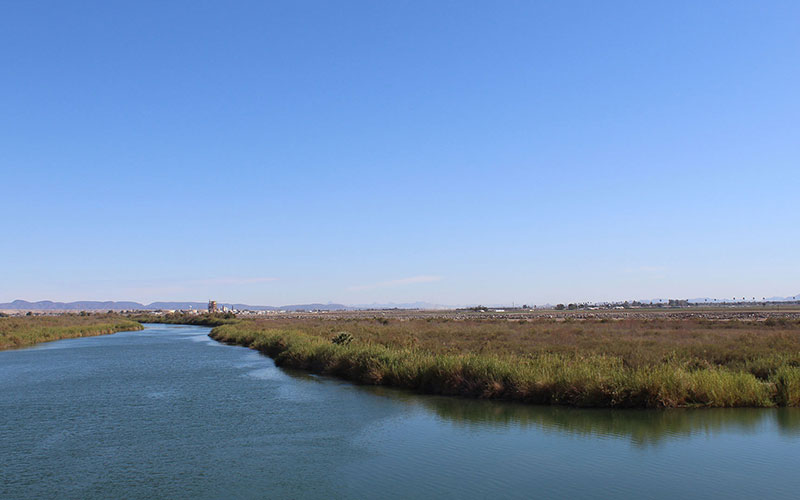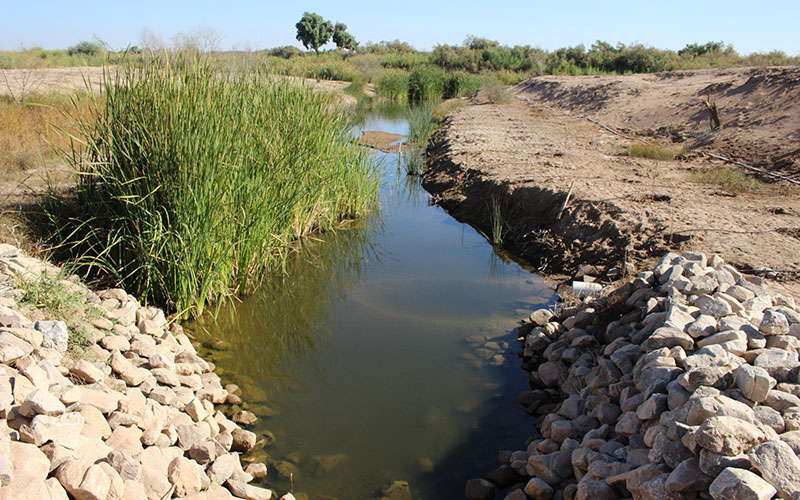TUCSON – President Donald Trump’s border wall now stretches along just more than 200 miles of U.S.-Mexico borderland. Progress hasn’t slowed during the COVID-19 pandemic; in some places it’s even accelerating. But there’s a tiny swath of tribal land along the lower Colorado River where that’s not the case.
The Cocopah Reservation sits in the river’s delta, a corner of the borderland where California, Arizona and Mexico meet. Members of the Cocopah Indian Tribe are among the 40 million residents of Western states who receive a share of water from the vast Colorado River basin.
But the Cocopah, who call themselves “the river people,” have been tied to the river far longer than those states have existed.
“The Colorado River where we are located is the line that divides us between the U.S. and Mexico,” said Joe Rodriquez, director of the tribal museum. “So the river itself is also on our land.”
The Gila River joins the Colorado nearby, and water used to flow all the way into the Gulf of California. Rodriquez said the river in the delta sustained the animals tribal members hunted, and it provided the mud for the houses they lived in. The Colorado always has been central to Cocopah life.
“The river water is life. Life,” he said. “It flows through our ancestral land. Everything that we need to sustain our tribe, ourselves, our families is obtained from the river itself.”
But access to that lifeline has been uncertain. The Trump administration is erecting a steel barrier 18 to 30 feet tall along parts of the U.S.-Mexico border. Until recently, that plan included the Cocopah’s 7 mile stretch of borderland east of the river. But in May, Trump administration attorneys removed funding for the Cocopah section in a response to lawsuits brought by the Sierra Club, California and other parties.
The administration cited difficult terrain and high building costs for its decision. But other wall sections planned in the area will cost as much if not more.
Tribal sovereignty is the real reason for the decision, said U.S. Rep. Raul Grijalva, D-Tucson.
“It would be foolish of Homeland Security of this administration to challenge sovereignty, because you’re challenging sovereignty at all levels if you do that,” he said. “(That is) a project they can’t win.”
Grijalva said this point has already been made – successfully – by the Tohono O’odham Nation, whose reservation in southern Arizona is the size of Connecticut. More than 60 miles of it runs along the border. Tribal leaders, including Chairman Ned Norris Jr., have been outspoken in their opposition to any barrier on their land. In February, Norris spoke at a congressional hearing about wall projects on ancestral Tohono O’odham land at Arizona’s Organ Pipe National Monument.
“For us this is no different from DHS building a 30-foot wall along Arlington cemetery,” he told the hearing in February.
Tohono O’odham ancestral land is also split by the U.S.-Mexico border, and some tribal members still live in Mexico. Wall segments continue to go up across Arizona wilderness now, but they stop at the boundary of the Tohono O’odham Nation Reservation.
Cocopah leaders haven’t opposed the wall publicly. They declined to comment on news of the funding being removed but provided a copy of a letter tribal lawyers sent to Customs and Border Protection in May.
In it, the lawyers said the tribe has been kept out of the loop about construction plans. They noted that the Cocopah have cooperated with agency requests in the past, allowing access roads, patrol vehicles and chest-high vehicle barriers on the 7 mile stretch along the border.
The letter called the area “the cultural and spiritual heart of the Cocopah homeland” and said building a 30-foot wall would cut off vital access to the Colorado River and family living on the other side.
“The Cocopah traditional lands and current relatives span the border area and know no country,” the letter continued. “The wall would separate Cocopah’s culturally tied relatives, negating a familial connection that is similar to the barrier created by the Berlin Wall.”
And it’s not just tribes who are worried about what a wall could do to the landscape. Jennifer Pitt, who directs the National Audubon Society’s Colorado River Program, is among the environmentalists who say that before agriculture, industry and cities, the Colorado delta was an oasis.
“This area was once an ecosystem of somewhere between one and a half to two million acres of wetlands, riparian corridors and mud flats,” she said.
Binational conservationists have spent years creating restoration sites on both sides of the border, Pitt said, but those could be blocked by other sections of the new wall.
Construction is continuing outside tribal land. Isaac Russell lives within a mile of the border just north of one section of the Cocopah Reservation. He and his wife used to bike through thickets of trees lining the river’s path along the border. That’s not possible now.
“They did massive amounts of clearing and they’re still doing more for (a) wall north of the (Morelos) dam. Cottonwoods, mesquites, palms,” Russell said. “A bunch of stuff.”
Water is diverted at the Morelos Dam, upstream from the Cocopah Reservation, and distributed to farming operations in Mexico. Russell said he worries what construction will do to water and wildlife around the area. His testimony now is part of a lawsuit against the wall project. But he said he didn’t know wall segments were even planned in his area until environmental groups told him in spring 2019.
Border Patrol requested public comment for the project back then, but Russell said the construction contract was awarded one day into the comment period. Work began last year.
In an email, the agency said it consults with tribes, border residents and other stakeholders on border wall projects. More than 50 miles of wall has already been built in the Yuma area, and construction is ongoing on 56 miles.


